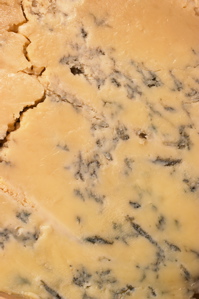Stilton
 |
According to a 19th century saying, if you "drink a pot of ale and eat a scoop of Stilton everyday, you will make 'old bones.'"
|
Long known as the "King of Cheeses," English Stilton is a rich,
creamy, slightly crumbly cheese with blue-green veins. It's less
aggressive and salty than other blue cheeses, offering a pungent, yet
mellow cheddar-like quality. Versatile and easy to use, Stilton is a
marvelous choice for cheese boards or a variety of starters and main
courses. However, some might argue it's best eaten all by itself with a glass of
sweet port wine.
History
Stilton was first made in the early 18th century around the Melton Mowbray area of England. It's produced with
the same traditional skills and standards today, because in 1936, the Stilton Cheesemakers'
Association was formed to protect its name and quality.
As a trademarked,
PDO (protected designation of origin) product, true Stilton can only be
made by authorized creameries in the three counties of Leicestershire,
Nottinghamshire and Derbyshire. There are currently just six licensed
Stilton creameries, and they produce over a million cheeses each year.
Varieties and Buying Tips
The familiar mature Stilton is made from whole cow's milk and allowed to ripen for four to six months. During this time, it's skewered with Pencillium roqueforti mold (also in Roquefort cheese) to encourage the growth of blue veins.
There is also a young white Stilton that's marketed before the colored veins develop. It has a mild and slightly sour flavor.
Authentic Stilton is traditionally made in tall, cylindrical
shapes with a crusty brownish rind. It's usually cut into small,
individually wrapped wedges for retail sale.
Storage Tips
Wrap Stilton in foil or plastic wrap and refrigerate in an airtight
container (this prevents the cheese from tainting other foods in the
fridge and vice-versa). It will keep for up to two weeks, and during
this time, will continue to mature and mellow.
For longer storage, Stilton may be frozen for up to three months.
Make sure it's well wrapped. To defrost, place in the refrigerator for
about 24 hours before using. This slow thaw will help the cheese retain
its creamy texture. Eat within one week and do not re-freeze.
Usage Tips
• Remove Stilton from the refrigerator up to two hours before eating—it's best at room temperature.
• Crumble over your favorite soups and salads.
• Add to mashed potatoes.
• Stir into mushroom risotto.
• Melt over steak during the last few minutes of cooking.
• Serve on a cheese board along with crackers, mango chutney, and a traditional English plum bread.
• Pair with Shiraz, Sauternes, Muscat, Olorosso Sherry or a fine tawny port.
Try one of our favorite Stilton recipes:





